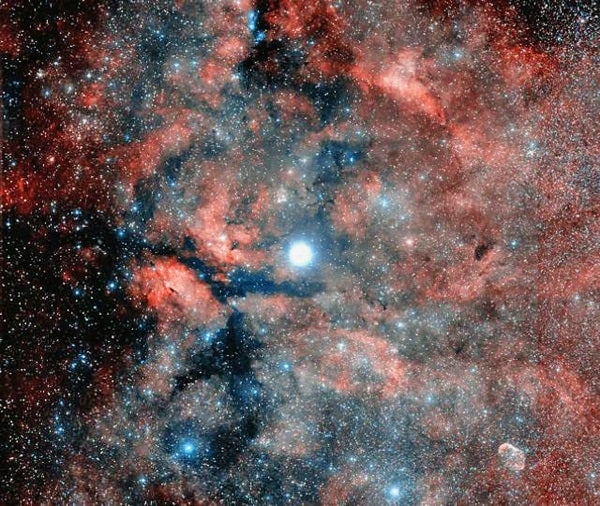An eerie glow
In color images, the beautiful nebula complex IC 1318 surrounds Gamma Cyg like the pink petals of a rose in bloom. It’s an illusion, however, because Gamma shines in the foreground 1,800 light-years from Earth, while IC 1318 glows perhaps 3,500 light-years farther away. Although American astronomer Edward Emerson Barnard discovered the nebula photographically, its brightest “petal” — IC 1318a — is visible under dark skies through small telescopes. With their wide fields of view, such scopes are best because the nebula measures about 50′ across — almost the apparent diameter of two Full Moons.
IC 1318a lies about 1¾° north-northwest of Sadr. This rich star-forming region doesn’t have a visual punch, being more like a wash of celestial ectoplasm. Look instead for an ethereal triangular glow whose tip points to the southwest. With imagination, IC 1318a looks like the island of Sicily swathed in moonlit mist. A much fainter, though equally robust, triangular extension flares off to the southwest, making the two clouds appear like a bipolar flow of nebulous matter projected against the patchy network of the Milky Way.
A dollop of darkness
Dark nebula Barnard 343 (B343) may be much more difficult to detect. It also lies 1¾° west of Sadr but in a much dimmer segment of the IC 1318 nebula complex.
Although B343 is a popular target among astrophotographers, this little “hole in the heavens” may present a challenge to the visual observer using a small telescope, especially from a city or suburb.
B343 is relatively small (13′), and the nebula surrounding it is faint, so the contrast between the darkness and the light is low. Nevertheless, I have glimpsed it through a 4-inch f/5 refractor at 23x. Seeing it well requires a keen knowledge of its position, a dark and transparent sky, low power, averted vision, and gentle tube-tapping techniques. Once you suspect you have it in your sights, try confirming the view with moderate magnification, around 75x. Do not expect this dark nebula to spring into view as a little ink spot. It looks more like a pale thumbprint, as if the “chalk” of the Milky Way has been smudged.
Know that these two visual challenges may require some time behind the eyepiece to confirm that what you are seeing is real and not some artifact created by the dappled star fields of the Milky Way. If you have trouble on your first attempt, return to the fields on another night, perhaps when the sky is more transparent, or try the view from a different location. Both nebulae are subtle, ethereal beauties — if you let your imagination free. As always, send your observations to sjomeara31@gmail.com.











